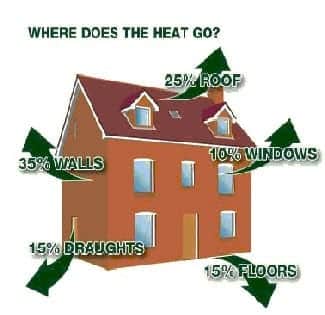How to Lower Energy Bills This Fall and Winter in Indianapolis
Find out how to lower energy bills at your home this fall and winter in and around Indianapolis!
As it always does in Indianapolis, the transition of seasons happens not like a dip into a heated pool, it’s more like being thrown into the north Atlantic. It’s certainly a shock to the senses that first 30 degree morning. And far too often, it’s a shock to your furnace, too.
While we can’t predict how long we’ll be in the midst of this fall glory, we are currently experiencing, we do know that winter will come with a smack to the face. So, while it’s still comfortable to do some work, we wanted to give some ideas to prepare your home for winter & reduce your bills in the process.
Let’s take a step back for a minute to explain why it’s more expensive to maintain a temperature in the winter. We don’t mean to be condescending at all, but we get the question alot, and it helps explain our recommendations. Look at it this way, let’s say your ideal home temperature is 70 degrees. In the summer, let’s say the average temperature is 85 degrees. You can do the math, that’s a 15 degree difference between inside & outside. On the flip side, let’s say the average temperature during the winter is 30 degrees – that’s a difference of 40 degrees! That’s nearly 3 times as much effort required in the winter as in the summer. Things like age of equipment, gas vs. electric, equipment efficiencies, all come into play when factoring in the exact increase in costs in the winter, but from that basic math above we know that it just takes more effort to hold your desired temperature.
So, we have to think strategically on what might help with our costs this winter. There are a few things we want to accomplish. Of all the things you can do, one of the simplest and most important is to get more warm air to the right places in your home & keep it there. What do I mean? Up to 30% of the heated air that you’re paying for is lost from seams in the ducts. While you won’t likely be able to every get that to 0%, you can increase that efficiency.
How to Lower Energy Bills Tip 1: Seal any leaks in ductwork.
Now that more warm air is getting through your system to your home, the next step is to keep it that temperature. It doesn’t take a degree in thermodynamics to grasp the fact these next steps. The greater the buffer between that cold outside air, and the toasty and expensive inside air, the longer it stays warm inside. The longer it can stay warm inside, the less demand requirements on your heating system, less demand means reduced cost. But, like with anything your home exterior wall thickness had a cost benefit analysis, and is not built like Fort Knox. Typically, you’ll have either 4 or 6 inches between you and outside, even less with windows.
How to Lower Energy Bills Tip 2: Seal cracks in exterior walls & windows.
As we all likely know, heat rises. The next thing we want to ensure is that rising heat, does rise too far, and start heating an unused space.
How to Lower Energy Bills Tip 3: Increase insulation in your attic.
Once you’ve done these steps, the next is to start to heat smarter. You wouldn’t turn on your bathtub and take off to work, would you? Yet, oftentimes we walk out of our home with the thermostat set on 70, without any awareness that it’s the same concept. I’m not saying to leave it off necessarily, but I am saying that there are smarter way to heat.
Bonus Tip: Install a programmable thermostat.
There are many options of very cost effective programmable thermostats on the market. Many of the Honeywell line offer HD screens, tell you outdoor temperature, and can make adjustments on their own. We recommend consulting an HVAC professional, if you have any questions.
With these 4 tips above, you should be prepared for the upcoming winter, and be prepared to save. Get more hot air out, keep more hot air in, and heat smarter, and you’ll have more money for the glorious Holidays right around the corner.
